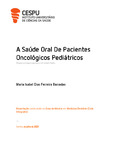| dc.contributor.advisor | VALE, TERESA CELESTE MAURÍCIO PEREIRA DO | |
| dc.contributor.author | Barradas, Maria Isabel Dias Ferreira | |
| dc.date.accessioned | 2023-11-16T11:31:36Z | |
| dc.date.available | 2023-11-16T11:31:36Z | |
| dc.date.issued | 2023 | |
| dc.identifier.uri | http://hdl.handle.net/20.500.11816/4293 | |
| dc.description.abstract | INTRODUÇÃO: Nos últimos anos, o cancro tornou-se um problema grave de saúde pública mundial. O termo “cancro infantil” é usado para classificar neoplasias em crianças com menos de 18 anos, sendo a sua principal causa de morte e tendo as leucemias como diagnóstico maligno mais frequente. Após diagnóstico, o tratamento oncológico deve ser iniciado o mais rápido possível. A maioria das crianças são tratadas com quimioterapia e/ou radioterapia. Porém, nas várias fases de tratamento e após o seu término surgem complicações na cavidade oral, sendo necessário uma avaliação por parte de um médico dentista. Pelas diretrizes atuais é recomendado que o médico dentista numa abordagem multidisciplinar com a equipa oncológica, realize um exame clínico e radiológico antes do início da terapêutica, pois cabe-lhe estabelecer estratégias de prevenção e fornecer orientações antecipadas relacionadas aos efeitos orais do cancro e do seu tratamento.
OBJETIVOS: Perceber a importância do acompanhamento do médico dentista no diagnóstico e plano de tratamento da cavidade oral das crianças diagnosticadas com cancro, submetidas à terapêutica oncológica.
MATERIAIS E MÉTODOS: Foi realizada uma pesquisa bibliográfica na base de dados PUBMED desde o ano de 2013.
RESULTADOS: A pesquisa resultou num total de 888 artigos e após análise, 16 foram selecionados para a realização desta revisão.
CONCLUSÃO: É importante a presença do médico dentista na equipa oncológica para um melhor diagnóstico e plano de tratamento oral que estas crianças precisam de realizar antes e após a terapêutica oncológica, instruindo os pais e as crianças sobre hábitos de higiene oral diária. | pt_PT |
| dc.description.abstract | INTRODUCTION: In recent years, cancer has become a serious public health problem worldwide. The term “childhood cancer” is used to classify neoplasms in children under 18 years of age, being the main cause of death and having leukemia as the most frequent malignant diagnosis. After diagnosis, cancer treatment should be started as soon as possible. Most children are treated with chemotherapy and/or radiotherapy. However, in the various stages of treatment and after its completion, complications arise in the oral cavity, requiring an evaluation by a dentist. According to current guidelines, it is recommended that the dentist, in a multidisciplinary approach with the oncology team, perform a clinical and radiological examination before starting therapy, as it is up to him to establish prevention strategies and provide advance guidance related to the oral effects of cancer and its treatment.
OBJECTIVES: To understand the importance of the follow-up of the dentist in the diagnosis and treatment plan of the oral cavity of children diagnosed with cancer, submitted to oncological therapy.
MATERIALS AND METHODS: A literature research was conducted in the PUBMED database since the year 2013.
RESULTS: The search resulted in a total of 888 articles and after analysis, 16 were selected for this review.
CONCLUSION: The presence of a dentist in the oncology team is important for a better diagnosis and oral treatment plan that these children need to carry out before and after cancer therapy, instructing parents and children about daily oral hygiene habits. | pt_PT |
| dc.language.iso | por | pt_PT |
| dc.rights | info:eu-repo/semantics/openAccess | pt_PT |
| dc.subject | Oncology | pt_PT |
| dc.subject | Oral health | pt_PT |
| dc.subject | Pediatric Dentistry | pt_PT |
| dc.subject | Pediatric oncology | pt_PT |
| dc.subject | Dental care | pt_PT |
| dc.subject | Oral manifestations | pt_PT |
| dc.title | A Saúde Oral De Pacientes Oncológicos Pediátricos | pt_PT |
| dc.type | info:eu-repo/semantics/masterThesis | pt_PT |
| dc.identifier.tid | 203373383 | pt_PT |
| thesis.degree.name | Mestrado em Medicina Dentária | pt_PT |

